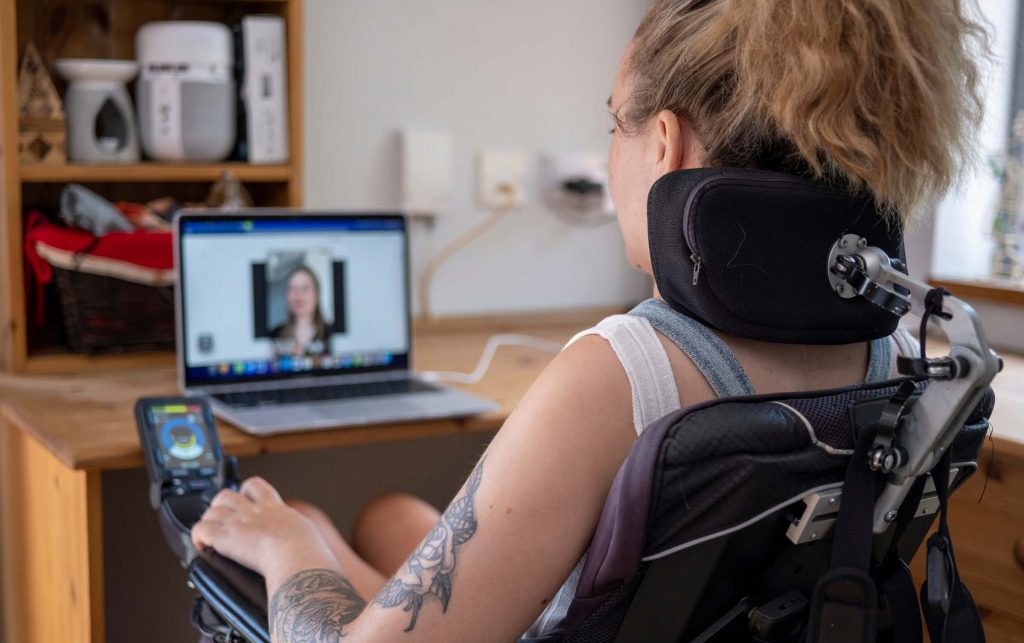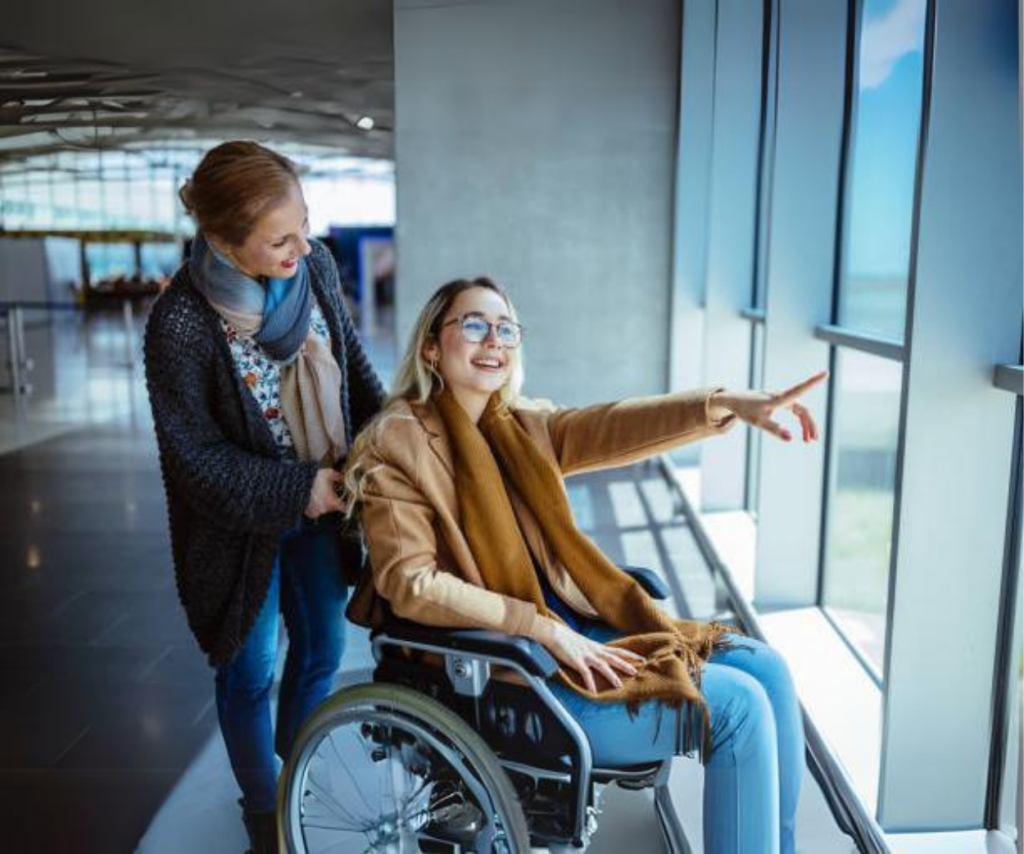Navigating the Skies
Challenges, solutions and ways to advocate to improve air travel for people who use mobility equipment

Last summer, Jonathan Lengel had the opportunity of a lifetime. A musician and an actor, Lengel, 17, was excited to take part in a study abroad music program in Spain. The trip was also the first time Lengel took his power chair on a flight.
“I took all the necessary precautions for traveling abroad,” recalls Lengel, who has a rare form of muscular dystrophy and uses a power chair for mobility. “We bubble wrapped parts of my chair, took parts of it off, put a sign on the seat with all the information the ground crew would need to know about how to handle the chair.”
When Lengel arrived in Madrid, his power chair arrived mostly intact. The seat cushion had been damaged, but the wheelchair was usable, and Lengel had an unforgettable experience in Spain. His return trip to the United States, an Iberia and American Airlines partner flight, was also unforgettable—just for a different reason.
“My dad and I were waiting for my chair to arrive at the jetway, but they told me I had to go through customs first to claim my chair,” Lengel said. “So I went through customs in an uncomfortable pushchair, and then we went down to baggage claim. We communicated to the crew that I really needed my chair. Then we heard a crash.”
Turned on its side and dripping wet from the summer storm soaking the airport, the 400-pound wheelchair was on the heavy luggage conveyor belt some three feet above the ground. Parts of the power chair were missing, while other broken components were piled atop the chair. With no one to help them get the heavy chair off the conveyor belt, Lengel and his dad left the airport without his power chair. The damaged chair was delivered to his driveway the next day.
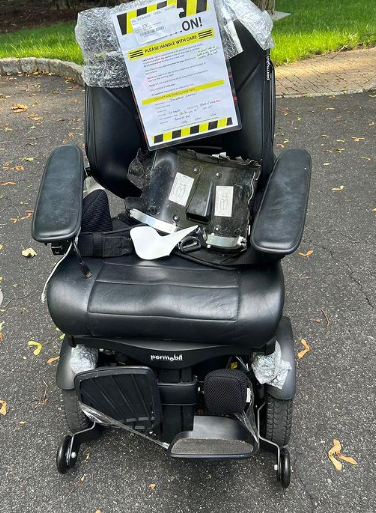
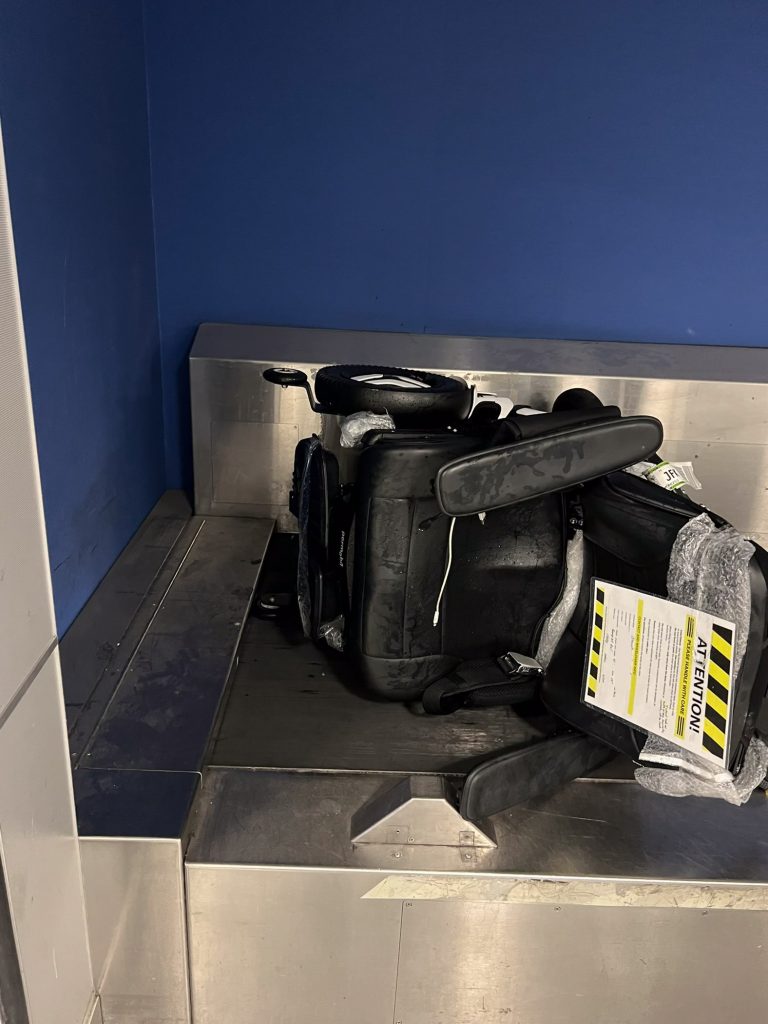
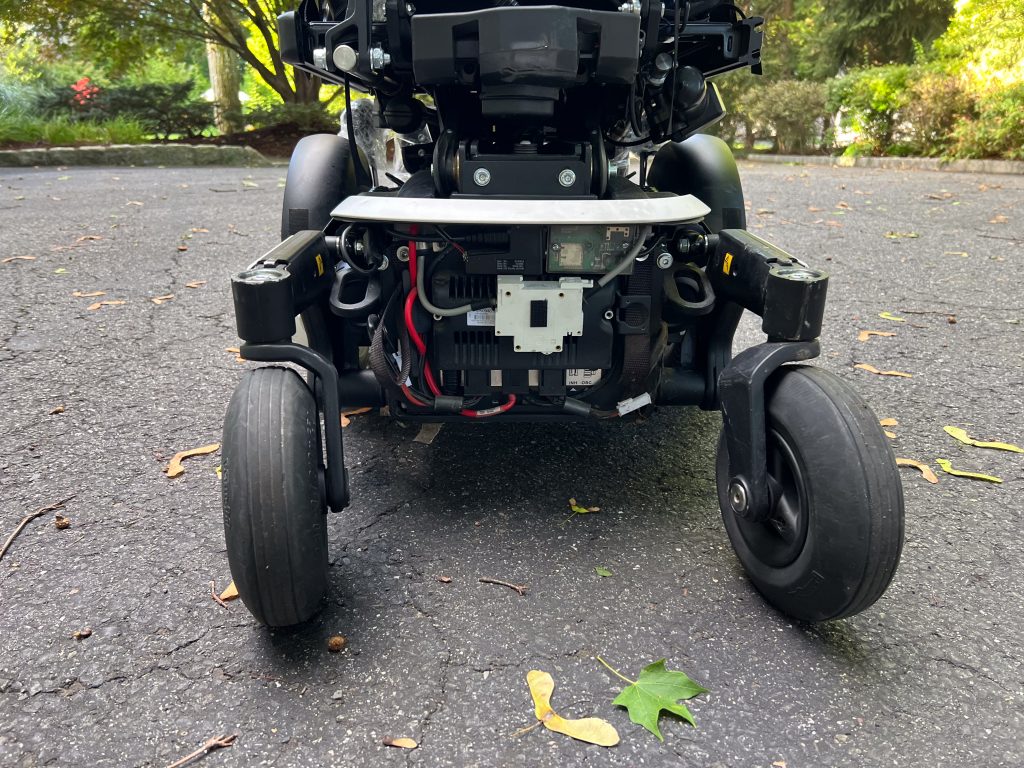
“It was just such a terrible experience after such a wonderful experience in Spain,” Lengel says. “I hope no one ever has to go through something like I did that night.”
Digging into the Data
While he hopes for the best, Lengel knows that many wheelchair users have faced similar experiences.
On average, according to data from the February 2024 Air Travel Consumer Report, the top 15 airlines damage about 63 mobility devices each month, for a total of 11,289 per year. It’s one thing to look at the data and another to recognize that it means more than 11,000 people who rely on mobility equipment for independence can’t live the kinds of lives they want to live.
“I don’t think that anyone purposefully or intentionally damages equipment,” said Brian Perkowski, an assistive technology professional (ATP) and NSM branch manager in New Jersey. “But until it happens to you or someone you know, unfortunately, you often don’t know how [damaging mobility equipment] really affects someone. Obviously, the mobility equipment we provide is completely customized. It’s priceless to the user. It’s their legs.”
The data, self-reported by the airlines and collected by the Bureau of Transportation Statistics, tells a sobering story that’s only getting worse, with damage equipment increasing year over year.
Perkowski says that some of the most common damages include ripped cushions and damage to anything that sticks out from the chair, such as headrests, joysticks and sensitive gimbals that allow users to control the chair and can’t always be removed. Broken straps and damaged harness clips, says Derek Miller, Division Vice President at NSM, are often common, as well as paint scrapes and push handle damage. Additionally, when a highly customized chair is tossed or mishandled, the frame can easily become twisted, which can cause catastrophic damage to the wheelchair.
“I remember working with clients who would come in and their chairs would come with a bent frame,” Miller says. “You can’t repair something with a twisted frame.”
Perkowski agrees.
“Think about when a car seat is in an accident,” he says. “If it’s in a crash, it’s out. You get a new car seat. If a wheelchair frame is twisted, you need a new chair.”
According to John Morris, the creator of Wheelchair Travel, a website devoted to accessible travel, damages to wheelchairs during travel aren’t uncommon. Damages like this are more than an inconvenience, Morris says, something airlines and the general public may not understand.
“We know how critical mobility equipment is to the freedom and lifestyles of disabled people, when that wheelchair, scooter or whatever it may be is damaged, it sends many people back into bedridden state and that’s not acceptable,” Morris said. “But there’s also a lot of uncompensated time involved, from waiting in the airport to working with the airline and scheduling a new fitting. It’s really frustrating.”
After their experience last summer, Lengel and his mother, Cheryl Dispoto, agree.
“Iberia Airlines actually called me at one point, after the replacement chair was already ordered through Global Repair Group (a Chicago-area company that works with many U.S. airlines to coordinate repair to mobility equipment damage during flights),” Ms. Dispoto recalls. “They asked us to give them receipts for what we’d already expended to rent a wheelchair and tell them the cost of a new chair, as if I was going to go to CVS and buy a custom-built wheelchair. So there was very little to no understanding from Iberia at all.”
Advocacy, Reform and Education
Advocacy and reform are vital to solving the problem, but Morris and Lengel are taking slightly different approaches to achieve that goal.
Lengel initially shared his story on Instagram and has continued to use the platform to advocate for change in addition to other avenues.
“I strongly encourage wheelchair users who experience any kind of damage to file formal complaints with the Department of Transportation, even if the airline fixes the damage. The government needs to be alerted every time this happens,” Lengel says. “As a young person who loves to travel, I’m not going to be satisfied until I can bring my power chair on the plane.”
Lengel is putting actions behind his words. He includes a link on his Instagram account that helps followers find and contact their state and federal legislators, and he and his family have contacted their local, state and federal representatives about the issue and their experience last summer. They’ve also filed a formal complaint with the Department of Transportation regarding the damage to Jonathan’s chair, in the hopes that his experience can help bring about change for others.
“Something really has to change,” Lengel says. “It can’t take 10 to 20 years.”
While legislation and government regulations are vital, Morris says transforming the travel experience for people who use wheelchairs has to involve the airlines and the people who design and build planes.
“Our government regulations are the foundation for civil rights and accessibility, and that shouldn’t be discounted,” Morris says. “But regulation is reactionary and rarely ahead of the curve. If we want to transform the experience that people are having today or at any point in the next two decades, it will have to come from working with the industry to demonstrate the challenges to create better design and better policies.”
Legislation and advocacy are key components of changing the status quo, but so is education, Miller says.
“The root of the problem is the mishandling of equipment,” Miller says. “If equipment was handled in a different manner, airlines wouldn’t need to pay for a $30,000 wheelchair that gets completely damaged.”
Perkowski also stresses the importance of educating airline employees from baggage handlers to gate agents about how to handle and care for mobility equipment.
“Education has to be the starting point,” he says. “But how do you teach that many people? Not just the baggage handlers, but the people at the gate and in the airport? Clients like Jonathan couldn’t even get help from the people coordinating luggage coming off the conveyor belt.”
Humanizing the problem is key and a good starting point, Perkowski says. If more people understand that a damaged wheelchair isn’t just an inconvenience, maybe that knowledge can become a catalyst for change.
“Change has to start somewhere,” Perkowski said. “If someone’s experience can help humanize the problem, then maybe that’s the starting point. Maybe that’s how we get something done.”
Forecasting on the Future
While both Morris and Lengel are looking forward to the day when people can remain in their wheelchairs while flying—Delta Air Lines revealed a prototype for an in-flight docking system last summer—both recognize that’s likely still years away.
Currently, most power chairs must be placed in the plane’s cargo hold with passenger’s luggage and other items. One way airlines could help, Morris says, is by being more transparent about the dimensions of the cargo door and hold.
“United agreed to list cargo door dimensions and other information on their website as part of a settlement agreement with the Department of Transportation,” he says. “It’s kind of sad that people have to come to my website to get a list of cargo door dimensions.”
According to Morris, most plane cargo doors are accessed by an opening that’s “significantly smaller than one would expect.”
“The most popular plane in the world is the Boeing 737, and the clearance space is only 33 inches,” he says. “So, compare that to the height of a typical power chair. That means, as wheelchair users, we have to think of some ways to reduce the size of the chair.”
That might mean removing the seat back or reclining the power chair before it goes in the cargo hold or removing pieces that might be easily damaged. That could include the joystick, which can be removed in some models, seat cushions, headrests, and, for manual wheelchair users, the wheels.
“It’s also helpful to provide information to the folks who will be handling your device,” Morris said. “Attach instructions to the chair, detail how to put it into free wheel mode, which can be difficult to decipher, and do what you can to make the process faster and easier for the staff.”
There are small signs of change, though. On May 16, President Joe Biden signed the FAA reauthorization bill into law. The bill reauthorizes the FAA through 2028, but also includes provisions to improve evacuation procedures for people with disabilities, create stronger enforcement of the Air Carrier Access Act and mandate training for personnel handling and storing wheelchairs during flights among other provisions.
In late February, the Department of Transportation (DOT) also announced a proposal designed to “ensure airline passengers who use wheelchairs can travel safely and with dignity,” according to a DOT press release. Among other things, the proposed rule would mandate enhanced training for employees who physically assist passengers with disabilities and handle mobility equipment while also making it easier for DOT to hold airlines accountable when they damage or delay the return of mobility devices. DOT has called for public comment on the proposal.
While these moves symbolize a bit of progress, it’s still a waiting game for complex rehabilitation technology (CRT) users. Lengel, who has passionately campaigned for FAA Reauthorization on social media, remains committed to advocating for change with a better future in view.
“It’s 2024, and traveling on a plane is still inaccessible,” he says. “I want to travel. I want to do the things anyone else can do and expect equal treatment. It shouldn’t be an ordeal.”
Related Articles
Back to School with Confidence
Navigating the Transition from Summer to School for CRT Users It’s back-to-school season, and the transition from a relaxed summer schedule to the more structured…
CRT Repair: Resolution, Repair & the Heart of the Matter
The Mobility Management podcast interview sheds light on the multifaceted challenges and urgent need for reforms in the repair and maintenance of Complex Rehab Technology…
Tips for Traveling with Your Wheelchair
Planning an upcoming trip? Perkowski, Morris and Lengel all suggested a few steps you can take to protect your wheelchair while flying. To learn more…

